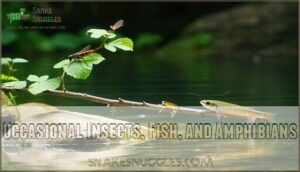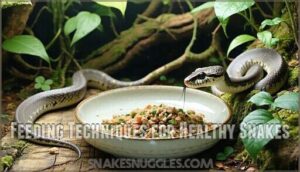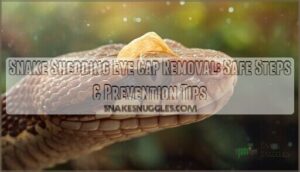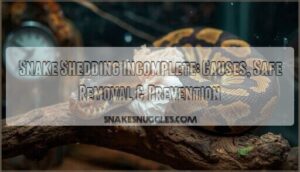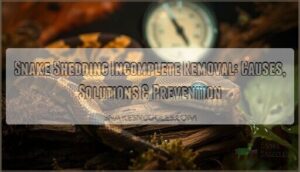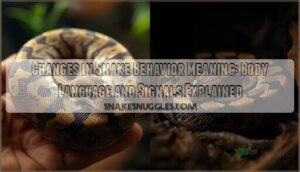This site is supported by our readers. We may earn a commission, at no cost to you, if you purchase through links.
 A wild-caught ball python once went nine months without eating—not due to illness, but because its previous owner fed it only live hamsters. Switching to properly sized frozen-thawed rats got the snake eating again within weeks. This story highlights a key point: what you feed your snake doesn’t just affect its appetite; it determines whether your pet thrives or merely survives.
A wild-caught ball python once went nine months without eating—not due to illness, but because its previous owner fed it only live hamsters. Switching to properly sized frozen-thawed rats got the snake eating again within weeks. This story highlights a key point: what you feed your snake doesn’t just affect its appetite; it determines whether your pet thrives or merely survives.
Snake nutrition isn’t as simple as tossing a mouse into the enclosure. Different species have evolved to eat specific prey, and captive snakes need a careful balance of protein, calcium, and vitamin D3 to avoid metabolic bone disease and other deficiencies. The difference between adequate nutrition and optimal health often comes down to understanding which prey provides the right nutrients—and which common options might do more harm than good.
Whether you’re caring for a juvenile corn snake or an adult boa, choosing the right food involves looking beyond convenience. Consider prey variety, preparation methods, and species-specific needs to ensure your snake stays healthy in the long run.
Table Of Contents
- Key Takeaways
- Essential Nutritional Needs for Snakes
- Top Healthy Prey Choices for Pet Snakes
- Live Vs. Frozen Prey: Safety and Ethics
- Feeding Techniques for Healthy Snakes
- Age and Species-Specific Diet Guidelines
- Dietary Restrictions and Unsafe Foods
- Hydration and Cleanliness in Snake Care
- Frequently Asked Questions (FAQs)
- Conclusion
Key Takeaways
- Frozen-thawed prey eliminates injury risks (15% bite wound rate with live prey) and parasite transmission while maintaining complete nutrition through whole vertebrate meals that provide balanced protein, calcium, and vitamin D3.
- Nutritional adequacy requires 30–50% protein, 3–8% fat, 0.8–1.1% calcium with a 2:1 calcium-to-phosphorus ratio, plus vitamin D3 supplementation for snakes without UVB exposure to prevent metabolic bone disease affecting 40% of captive reptiles.
- Prey variety matters significantly—rotating rodents with quail, Reptilinks, or species-appropriate alternatives (fish for garter snakes, insects for smaller species) mimics wild dietary diversity and prevents nutritional deficiencies that live-only or single-prey diets create.
- Feeding frequency and prey size must match life stage: hatchlings need meals every 5–7 days with pinky-sized prey, while adults thrive on 10–14 day schedules with appropriately girthy rodents, adjusted by species-specific preferences and body condition monitoring.
Essential Nutritional Needs for Snakes
Your snake’s health starts with the right nutritional foundation. Understanding what snakes need—protein for growth, calcium for bone strength, fat for energy, and vitamin D3 for absorption—helps you make informed feeding decisions.
Here’s what these nutrients do and how your snake gets them from prey.
Protein, Fat, and Calcium Requirements
Your snake’s diet depends on three key elements: protein, fat, and calcium. Carnivorous reptiles need 30–50% protein in their dry food to keep muscles and organs healthy. Keep fat levels between 3–8% to avoid obesity and liver issues. Aim for calcium at 0.8–1.1%, with a calcium-to-phosphorus ratio around 2:1 for strong bones and overall health.
To feed your reptile properly, you need to understand reptile dietary needs for a balanced diet.
Importance of Vitamin D3
Without enough vitamin D3, snakes can’t absorb calcium properly—up to 80% passes through undigested. Whole vertebrate prey usually provides enough D3, but snakes kept indoors without UVB lighting may need vitamin supplements every other feeding or every third one.
UVB exposure between 290–315 nm triggers natural D3 synthesis in a snake’s skin. Deficiency leads to metabolic bone disease, affecting about 40% of captive reptiles during their lives.
Understanding vitamin D3 benefits is key for preventing these diseases in snakes.
Role of Balanced Prey Variety
Feeding your snake the same prey every week is like eating chicken for every meal—your pet needs variety for a balanced diet. Prey rotation provides essential nutrients by mixing up fatty acids, vitamins, and minerals.
A carnivorous diet with feeding variety mimics what snakes eat in the wild, where meals are never the same. Whole prey options like mice, rats, and quail offer the dietary diversity your snake needs to thrive.
When to Use Supplements
Even with a balanced diet, your snake might occasionally need supplements—though probably less often than you’d expect. These products can help fill nutritional gaps when whole prey doesn’t quite cut it, but in most cases, a varied prey menu handles everything your snake requires.
Consider dietary enhancers when:
- Your snake refuses varied prey items, limiting natural vitamin needs
- Calcium supplements become necessary during growth or egg production
- Mineral boosters correct specific deficiencies your veterinarian identifies
Most snake dietary restrictions don’t require routine supplementation—snake diet quality matters more than adding powders.
Top Healthy Prey Choices for Pet Snakes
Choosing the right food is key to keeping your snake healthy and happy long-term. Most pet snakes eat rodents, but mixing in other options like birds or special commercial meals can improve their diet and keep things interesting.
Here’s a breakdown of the main food options that satisfy your snake’s carnivorous diet without compromising their safety.
Frozen-Thawed Mice and Rats
Frozen-thawed rodents are the go-to choice for feeding captive snakes, offering whole prey that mimics what they’d eat in the wild, without the risks of live feeding. You can find mice and rats in various sizes—from pinky to jumbo—to match your snake’s growth stages. Proper freezer storage keeps nutrients intact for months, and careful thawing preserves their quality.
Using frozen-thawed prey eliminates the risk of defensive bites that can harm snakes, while whole prey provides a balanced mix of calcium, vitamins, and protein. In the debate between live and frozen prey, frozen options consistently win for safety and convenience.
| Rodent Size | Snake feeding guidelines | Feeding Frequency |
|---|---|---|
| Pinky/Fuzzy | Hatchlings, small juveniles | Every 5–7 days |
| Hopper/Weaner | Growing juveniles | Every 7–10 days |
| Adult/Jumbo | Mature snakes | Every 10–14 days |
Quail, Button Quail, and Quail Eggs
If you want to mix up your snake’s diet, quail and their eggs are a great option. Button quail offer whole prey enrichment, while quail eggs provide concentrated protein and egg yolk benefits, rich in vitamins A and D3.
You can feed frozen-thawed quail meat or whole chicks, depending on your snake’s size, and rotate these game bird meals with rodents for a varied diet.
Reptilinks and Commercial Alternatives
Reptilinks offer a practical, all-in-one feeding solution for reptiles—essentially whole prey molded into convenient link form.
Each link contains everything your reptile needs: meat, bone, and organs, with calcium-to-phosphorus ratios ranging from 1:1 to 2:1. This balance helps protect against metabolic bone disease.
Some frozen options even come fortified with organic greens and berries, offering more than just a basic rodent diet. Snakes’ acceptance of Reptilinks can differ—some take to them right away, while others may need a bit of scenting or a gradual introduction to switch from their usual live food.
Green Anoles and House Geckos
For smaller snake species or hatchlings that aren’t ready for a full rodent yet, green anoles and house geckos serve as protein-rich stepping stones between invertebrates and larger prey.
These small lizard care options offer excellent reptile nutrition with manageable sizing—usually 4-6 inches—making them ideal exotic prey options for juvenile corn snakes or rough green snakes.
When incorporating anole nutrition or gecko feeding into your reptile husbandry routine, source captive-bred specimens to minimize parasite transmission and keep your snake diet balanced with occasional, rather than exclusive, live food offerings.
Occasional Insects, Fish, and Amphibians
While rodents form the backbone of most snake diets, certain species in the wild regularly hunt crickets, minnows, or tadpoles—and you can replicate this dietary diversity in captivity with careful planning.
For pet snakes with specialized reptile dietary needs, consider these occasional supplements:
- Insect nutrition: Crickets and roaches boost protein for smaller species
- Fish diets: Freshwater minnows suit garter snakes’ natural preferences
- Amphibian feeding: Tadpoles provide nutrient-rich variety for aquatic hunters
- Worm supplements: Earthworms deliver essential minerals supporting overall animal nutrition and health
Live Vs. Frozen Prey: Safety and Ethics
Choosing between live and frozen prey isn’t just about convenience—it directly affects your snake’s safety and well-being. Live prey can injure or stress your snake, while frozen-thawed options eliminate these risks and offer practical benefits.
Here’s why frozen prey stands out as the safer, more humane choice for most keepers.
Risks of Feeding Live Prey
You’re playing a dangerous game when you offer live prey—it’s not instinct feeding, it’s exposing your snake to preventable trauma. Bite wounds occur in roughly 15% of live-feeding cases, often requiring surgical repair or leading to fatal infections like septicemia. Live rodents can damage eyes, mouths, and internal organs during defensive struggles, with some injuries exposing bone.
When prey is left unsupervised, your snake’s stress levels spike—weakening its immune system and sometimes causing it to stop eating altogether. The dangers don’t stop at physical injuries. Live rodents carry parasites and can spread Salmonella to both you and your pet.
There’s also an ethical dimension here: some areas have actually banned live feeding because of animal welfare concerns. At the end of the day, choosing your snake’s food isn’t just about what’s easiest—it’s about matching prey size to your snake’s needs while minimizing risk. That’s why most experienced keepers stick with frozen.
| Risk Category | Documented Consequences |
|---|---|
| Physical Injury | Puncture wounds, eye damage, tissue loss requiring emergency care |
| Disease & Infection | Salmonella, E. coli transmission; potential septicemia and death |
| Behavioral Stress | Elevated stress hormones, feeding refusal, compromised shedding |
Benefits of Frozen-Thawed Options
Frozen-thawed prey flips the script entirely—you’re getting convenience, cost savings, and measurable safety improvements without sacrificing your snake’s nutritional needs. Bulk purchasing reduces costs by 40–60%, while eliminating parasite transmission risks inherent to live feeding. Thawed feeding protocols maintain prey variety without compromising snake nutrition—you’ll rotate rodent species, introduce quail, and customize meal safety with frozen-thawed prey stored for months.
| Benefit | Live Prey | Frozen-Thawed Prey |
|---|---|---|
| Injury Risk to Snake | 15% bite/scratch incidents | Zero defensive injury potential |
| Parasite Transmission | High (intestinal worms, mites) | Eliminated via freezing protocols |
| Cost Efficiency | $3–5 per feeder | $1–2 per frozen unit (bulk) |
| Storage & Convenience | Requires housing/maintenance | 6–12 month freezer storage |
Training Snakes to Accept Dead Prey
You won’t need elaborate conditioning tricks—most snakes adapt to frozen-thawed prey within three to five feeding cycles using gradual acclimation protocols. Start by “braining” thawed rodents (exposing cranial contents) to boost scent cues, then progress to whole prey presentation using feeding tongs. Movement simulation—gently wiggling prey with forceps—triggers strike responses in hesitant feeders.
| Feeding Week | Snake Training Method |
|---|---|
| Week 1–2 | Brain exposed prey, warm to 100°F |
| Week 3–4 | Whole prey with tong movement |
| Week 5–6 | Static prey presentation |
| Week 7+ | Standard frozen-thawed feeding |
Ethical and Welfare Considerations
Beyond mastering feeding techniques, the choice between live and frozen prey carries real consequences for both your snake’s safety and the welfare of feeder animals.
Animal welfare and ethics demand humane treatment throughout the feeding process—frozen prey eliminates prolonged distress for rodents while reducing injury risk to your snake. Conservation impact extends beyond your enclosure: responsible pet snake care and health practices model welfare standards that influence broader reptile diet and digestion protocols.
| Ethical Consideration | Frozen-Thawed Advantage |
|---|---|
| Feeder Animal Distress | Instantaneous euthanasia vs. prolonged fear |
| Snake Rights Protection | Zero bite/scratch wounds |
| Veterinary Medicine Standard | Recommended by exotic specialists |
| Humane Treatment Protocol | Pre-killed compliance with animal ethics |
| Animal Nutrition Quality | Parasite-free, consistent prey size |
Feeding Techniques for Healthy Snakes
Feeding your snake properly isn’t just about what you offer—it’s about how you do it. The right techniques protect both you and your snake while encouraging consistent eating habits.
Here are the methods that keep feeding time safe and stress-free.
Proper Thawing and Warming of Prey
Thawing frozen prey incorrectly can turn a safe meal into a bacterial breeding ground or leave your snake facing a meal that’s too cold to trigger its feeding response.
Follow this step-by-step thawing guide:
- Store frozen prey in your freezer and move it to the refrigerator 1-2 days before feeding—never thaw at room temperature initially.
- Bring thawed prey to room temperature a few hours before feeding by placing it in a sealed bag in warm (not hot) water.
- Check prey temperature by feeling the body cavity; it should be lukewarm to properly stimulate your snake’s thermal receptors and feeding instinct.
Using Feeding Tongs and Separate Containers
Feeding tongs and a dedicated container aren’t just nice-to-have accessories—they’re your best defense against turning your docile snake into a cage-territorial predator. When you use tongs to handle prey, you won’t trigger a feeding response toward your hands.
Transfer your snake to a separate feeding container with adequate ventilation—this keeps substrate out of the meal and trains your snake that feeding time happens elsewhere, not in its everyday space.
Preventing Substrate Ingestion and Aggression
Substrate ingestion is one of the top preventable feeding issues in captive snakes, but it’s completely avoidable with the right approach. Feeding your snakes in separate containers instead of their main enclosure eliminates substrate risks and significantly reduces cage aggression.
This method prevents snakes from associating their home with food, keeping feeding schedules consistent and behavior more manageable. A well-designed enclosure reinforces this routine, helping you avoid territorial strikes that occur when snakes expect food in their regular space.
Monitoring Feeding Behavior
Observing your snake’s feeding response tells you more about its health than almost any other care routine. Appetite changes, food refusal, and digestion issues often signal stress, illness, or environmental problems before other symptoms appear. Track your snake’s eating habits and feeding schedule carefully—consistent patterns help you recognize when something’s off.
Key feeding cues to monitor regularly:
- Strike speed and precision – Healthy snakes exhibit confident, accurate strikes; hesitation may indicate vision problems or weakness
- Feeding frequency deviations – Sudden appetite changes outside normal shed cycles warrant closer examination
- Post-feeding behavior – Watch for regurgitation, abnormal swelling, or prolonged digestion times beyond species norms
- Seasonal appetite fluctuations – Many species naturally reduce intake during breeding season or cooler months
- Prey preference shifts – Unexplained food refusal in previously reliable eaters often signals husbandry issues requiring adjustment
Age and Species-Specific Diet Guidelines
Your snake’s dietary needs shift dramatically as it grows, and different species have entirely different feeding requirements. A hatchling corn snake won’t eat the same prey as an adult ball python, and what works for a garter snake won’t suit a boa constrictor.
Here’s how to match your feeding approach to your snake’s age and species.
Feeding Juvenile Vs. Adult Snakes
As your snake grows from a hatchling into a full-grown adult, its dietary needs change significantly. Mistiming these changes can lead to stunted growth or obesity.
Young snakes need frequent meals—usually every 5–7 days—to support their rapid development. Adults, however, do well with monthly feedings. Prey size should increase accordingly: hatchlings start with pinky mice, while mature corn snakes can handle adult rodents.
| Life Stage | Feeding Frequency | Typical Prey Size |
|---|---|---|
| Juvenile | Every 5–7 days | Pinky to fuzzy mice |
| Adult | Every 14–30 days | Adult mice or small rats |
Adjust feedings based on your snake’s body condition and specific nutritional needs.
Dietary Preferences by Snake Species
Different snake species have evolved to eat different prey, shaping their nutritional needs and feeding habits. Understanding these dietary adaptations helps you meet your snake’s specific needs.
- Colubrids (corn snakes, rat snakes, king snakes) accept the widest prey variety, thriving on rodents, birds, and occasional reptiles
- Boas and pythons overwhelmingly prefer endothermic prey—97% of their diet consists of rodents and birds in both wild and captive settings
- Garter and water snakes consume fish and amphibians for over 70% of their nutritional requirements
- Elapids (coral snakes) target reptiles and amphibians primarily, with 92% of field records reflecting this preference
- Viperids (rattlesnakes) focus on small mammals, with 81–95% mammalian prey composition depending on region
Match your corn snake’s feeding habits or other species’ natural dietary patterns to promote good health and gut microbiota balance.
Adjusting Prey Size and Feeding Frequency
Choosing the right prey size is like picking the perfect pair of shoes—too small leaves them hungry, and too large can cause injury or regurgitation. Your feeding guide should match the prey’s diameter to your snake’s widest body point, never exceeding it.
Young pet snakes need meals every 5–7 days for healthy growth, while adults do well on a 10–14 day schedule. Keep a close eye on weight management, adjusting meal frequency and frozen prey size as your snake grows. Always thaw prey properly before feeding.
Special Considerations for Corn Snakes
Corn snakes are one of the easiest species to care for in captivity, with a diet that’s simpler than many of their more specialized relatives. Frozen-thawed mice work well throughout their lives, as long as you match the prey size to your snake’s girth.
Feeding schedules are straightforward: every 5–7 days for hatchlings, and every 10–14 days for adults. This makes corn snake feeding habits easy to manage in any setup.
Dietary Restrictions and Unsafe Foods
Not all food is safe for your snake, and some feeding practices can lead to serious health problems. Knowing what to avoid is just as important as knowing what to feed.
Here’s what every snake owner needs to know about dietary restrictions and the warning signs that indicate trouble.
Foods and Prey to Avoid
You’ll want to steer clear of several categories of prey and non-prey items that pose serious risks. Live rodents can inflict severe bite wounds—up to 11% of cases require surgery. Wild-caught prey carries pesticides (documented in 71% of environments) and parasites (32% transmission rate).
Goldfish and similar fish contain thiaminase, causing neurological damage in 23% of snakes. Toxic amphibians like salamanders produce lethal compounds with 2-4x higher mortality rates.
Processed foods, fruits, vegetables, and non-prey items cause obstruction, toxicity, and deficiencies. Stick exclusively to frozen prey from reputable sources—never raw meats or household scraps.
Dangers of Improper Diets
Skip these nutritional guidelines, and you’re setting up a domino effect of health problems that could shave years off your snake’s life. An unbalanced diet creates serious risks:
- Metabolic bone disease from inadequate calcium and vitamin D3—leading to skeletal deformities
- Weakened immune function from nutrient gaps—boosting infection risk by 40%
- Organ failure from incorrect protein-to-fat ratios—a top cause of early death in veterinary records
Proper nutrition isn’t optional. Your snake’s health depends on it.
Warning Signs of Nutritional Deficiency
Your snake’s body clearly shows when nutrient imbalance occurs. Deficiency symptoms like swollen jaw bones, retained shed, persistent anorexia, and muscle tremors are strong signs of malnutrition.
Dietary issues often lead to lethargy, seen in 62% of cases, while chronic diarrhea points to absorption problems. Keep an eye out for bone deformities, skin tears, or stargazing behavior as part of regular health checks.
Meeting nutritional needs is non-negotiable: protein, calcium, and vitamin D3 deficiencies appear quickly and require prompt veterinary care to avoid lasting harm.
When to Consult a Veterinarian
If your snake skips meals for more than three feedings in a row or shows any of the warning signs mentioned earlier, it’s time to see a vet. Don’t wait for things to get worse—anorexia lasting over two weeks, breathing difficulties, or neurological issues like stargazing need immediate attention.
Regular check-ups with a vet experienced in reptiles can help catch feeding problems early, preventing complications that could harm your snake’s long-term health.
Hydration and Cleanliness in Snake Care
A nutritious diet is key to your snake’s health, but proper hydration and a clean enclosure are just as vital for preventing illness and supporting natural processes like shedding.
The water you provide and how you keep their space clean directly affect your snake’s immune system, skin health, and overall energy.
Here’s how to ensure your snake stays well-hydrated with a spotless living space.
Importance of Fresh Water and Proper Bowls
Water isn’t just a nice-to-have in your snake’s enclosure—it’s key for proper hydration, healthy shedding, and overall vitality. When setting up water for your pet snake, consider these reptile care essentials:
- Bowl size – Choose a dish large enough for snake soaking and body submersion
- Water quality – Replace daily to prevent bacterial growth
- Water temperature – Keep at room temperature for best animal health and wellness
- Stability – Use heavy ceramic crocks that won’t tip during movement
Your snake’s hydration tips start now: accessibility matters as much as cleanliness in thorough pet care.
Maintaining Humidity for Health and Shedding
Beyond keeping your snake’s water bowl topped off, humidity levels are just as important for respiratory function, skin elasticity, and successful shedding cycles. Most species do well between 40–60% relative humidity, though tropical pythons need 60–80%. Use a digital hygrometer to monitor levels and provide a humid hide during shedding.
| Species Type | Ideal Humidity Range | Humid Hide Recommendation |
|---|---|---|
| Desert species (e.g., corn snakes) | 40–50% | Optional, shedding only |
| Temperate colubrids | 50–60% | Recommended year-round |
| Tropical pythons | 60–70% | Essential always |
| Boas | 60–80% | Essential always |
| Ball pythons | 55–65% | Recommended year-round |
Proper snake hydration and good reptile care practices help keep your pet snake healthy and happy.
Safe Disinfecting Practices (e.g., Chlorhexidine Solution)
Keeping your snake’s habitat free from pathogens takes more than a quick rinse—you need a disinfectant that kills bacteria without leaving harmful residues. Chlorhexidine solution (0.05–0.1%) is a great choice for sanitizing, helping prevent disease without harming your pet snake.
Follow these hygiene steps:
- Dilute properly – Mix according to the product instructions for effective reptile care.
- Rinse thoroughly – Remove all disinfectant residue before reintroducing your snake.
- Air-dry completely – Let bowls and surfaces dry fully to eliminate pathogens.
These cleaning practices protect your snake’s health and nutrition.
Daily Cleaning and Water Replacement Tips
Fresh water isn’t an occasional treat—it’s a daily necessity to keep your snake hydrated, healthy, and shedding smoothly. Check your snake’s water bowl each morning for any mess, then refill it with clean water.
Use a pet-safe disinfectant when cleaning the bowl to control humidity and prevent bacteria. Keeping the water bowl clean is key to a tidy snake enclosure and great reptile care.
Frequently Asked Questions (FAQs)
How often should I change my snakes water?
Daily care for your pet snake requires consistent attention. Change its water daily and clean the bowl to keep your snake healthy and maintain proper humidity.
This simple routine is key to good snake care.
Can snakes eat eggs from the grocery store?
Some snakes naturally eat eggs, but grocery store eggs can be risky. Egg nutrition differs, and snakes need specific prey for proper digestion.
Grocery store eggs may contain chemicals and bacteria. Instead, offer safer options like quail eggs or frozen rodents to meet their nutritional needs.
What temperature should thawed prey reach before feeding?
For frozen-thawed prey, aim for a perfect temperature of around 98–100°F, matching your snake’s body heat.
Start by warming the prey to room temperature, then use warm water or gentle heat to reach the ideal feeding temperature. This process mimics live prey, encouraging your snake to feed naturally.
How do I know if my snake is overweight?
To check a snake’s weight, inspect its body condition by looking for visible vertebrae or rib definition, which indicate underweight, or rounded contours and fat near the tail, signaling potential obesity.
Monitor feeding habits and adjust portions to meet nutritional needs, ensuring proper care for your pet snake.
Should I feed my snake before or after handling?
You’ll want to touch your snake after feeding—but wait at least 48 hours. Touching too soon risks regurgitation due to snake stress and disrupted digestion.
Follow proper feeding schedules using frozen food or live food, then observe snake behavior. Post touch care calls for patience.
Conclusion
Providing healthy snake food options isn’t rocket science—it’s about understanding your snake’s natural prey preferences and meeting its nutritional needs through properly prepared meals. Whether you’re offering frozen-thawed rodents, quail, or commercial alternatives, prioritize prey that delivers complete nutrition without risk.
Monitor your snake’s body condition, adjust feeding schedules as it grows, and maintain clean water daily. When you combine species-appropriate diet choices with safe feeding techniques, you’re not just feeding your snake—you’re investing in years of vibrant health and natural behavior.
- https://www.merckvetmanual.com/management-and-nutrition/nutrition-exotic-and-zoo-animals/nutrition-in-reptiles
- https://reptilinks.com/pages/the-links
- https://www.visionproducts.us/blog/frozen-vs-live-rodents-what-should-i-feed-my-snake/
- https://aqach.com/live-nutrition/reptiles-live-nutrition/
- https://www.reddit.com/r/snakes/comments/1i7gf3j/live_vs_frozen_food/





